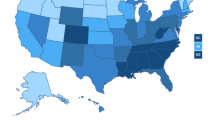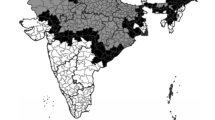Abstract
Currently, Temporary Assistance for Needy Families (TANF) programs in 32 American states allow low-income childless pregnant single women (CPSW) to receive monthly cash assistance, while 28 states and the District of Columbia use lump-sum payments to divert low-income families from TANF. Past research has not investigated the possible consequences on abortions of these two welfare policies. We construct a theoretical model of low-income CPSW to investigate them. The results of the theory yields the following hypotheses: (1) diversion payments to low-income mothers lower abortion incidence; and (2) diversion payments and CPSW eligibility together raise abortion incidence. We use data from the US Centers for Disease Control and Prevention’s Abortion Surveillance, and a system GMM dynamic panel, two-way fixed-effects empirical model to test our hypotheses. Our empirical results provide statistically significant evidence for the first hypothesis, but not the second.
Similar content being viewed by others
References
Adema W, Gray D, Kahl S (2003) Social assistance in Germany. OECD Labour Market and Social Policy Occasional Papers, No. 58, OECD Publishing
Anderson T, Hsiao C (1982) Formulation and estimation of dynamic models using panel data. J Econom 18(1): 47–82
Arellano M, Bond S (1991) Some tests of specification for panel data: Monte Carlo evidence and an application to employment equations. Rev Econ Stud 58(2): 277–297
Arellano M, Bover O (1995) Another look at the instrumental-variable estimation of error-component models. J Econom 68(1): 29–52
Bankole A, Singh S, Haas T (1999) Characteristics of women who obtain induced abortion: A worldwide review. Int Fam Plan Perspectives 25(2): 68–77
Barber G, Daugherty B, McAdams D (2002) An alternative to TANF: experience with Kentucky’s Family Alternative Diversion Program. Presented at the National Association of Welfare Research and Statistics Annual Conference, Albuquerque, NM
Berggren N (1997) Rhetoric or reality? An economic analysis of the effects of religion in Sweden. J Socioecon 26(6): 571–596
Bertrand M, Luttmer E, Mullainathan S (2000) Network effects and welfare cultures. Q J Econ 115(3): 1019–1056
Bettarini S, D’Andrea S (1996) Induced abortion in Italy: levels, trends and characteristics. Fam Plann Perspectives 28(6): 267–271, 277
Blank R (2001) What causes public assistance caseloads to grow. J Hum Resour 36(1): 85–118
Blank R (1988) The effect of welfare and wage levels on the location decisions of female-headed households. J Urban Econ 24(2): 186–211
Blayo C (1995) L’évolution du recours a l’avortement en France depuis 1976. Population 50(3): 779–810
Blundell R, Bond S (1998) Initial conditions and moment restrictions in dynamic panel data models. J Econom 87(1): 115–143
Burke V (2003) Welfare reform: TANF trends and data. Congressional Research Service Report 98–369 EPW. http://digital.library.unt.edu/govdocs/crs/index.txl. Accessed 25 Feb 2008
Camasso M (2004) Isolating the family cap effect on fertility behavior: evidence from New Jersey’s Family Development Program Experiment. Contemp Econ Policy 22(4): 453–467
Centers for Disease Control and Prevention, CDC (2000) Abortion Surveillance–United States, 1997. MMWR 49(SS-11). http://www.cdc.gov/mmwr/sursumpv.html. Accessed 20 Dec 2008
Centers for Disease Control and Prevention, CDC (2003) Abortion Surveillance–United States, 2000. MMWR 52(SS-12). http://www.cdc.gov/mmwr/sursumpv.html. Accessed 20 Dec 2008
Centers for Disease Control and Prevention, CDC (2006) Abortion Surveillance–United States, 2003. MMWR 55(SS-11). http://www.cdc.gov/mmwr/sursumpv.html. Accessed 20 Dec 2008
Daponte B, Sanders S, Taylor L (1999) Why do low income households not use food stamps? Evidence from an experiment. J Hum Resour 34(3): 612–628
David H (1992) Abortion in Europe, 1920–91: a public health perspective. Stud Fam Plan 23(1): 1–22
De Jong G, Graefe D, St Pierre T (2005) Welfare reform and interstate migration of poor families. Demography 42(3): 469–496
Dyer W, Fairlie R (2004) Do family caps reduce out-of-wedlock births? Evidence from Arkansas, Georgia, Indiana, New Jersey and Virginia. Popul Res Policy Rev 23: 441–473
Edwards J, Thames F, Edwards M (2006) Measuring the dissemination of volatility across levels of development. Topics Macroecon 6(2)
Epstein L, Zin S (1989) Substitution, risk aversion, and the temporal behavior of consumption and asset returns: a theoretical framework. Econometrica 57(4): 937–969
Fang H, Keane M (2004) Assessing the impact of welfare reform on single mothers. Brookings Papers Econ Activity 1: 1–95
Fang H, Silverman D (2004) On the compassion of time-limited welfare programs. J Public Econ 88(7–8): 1445–1470
Finer L, Henshaw S (2003) Abortion incidence and services in the United States in 2000. Perspectives Sex Reproductive Health 35(1): 6–15
Finer L, Frohwirth L, Dauphinee L, Singh S, Moore A (2006) Timing of steps and reasons for delays in obtaining abortions in the United States. Contraception 74(4): 334–344
Garbacz C (1990) Abortion demand. Popul Res Policy Rev 9: 151–160
Grogger J, Karoly L, Klerman J (2002) Consequences of welfare reform: a research synthesis. Document DRU-2676-DHHS, Prepared by RAND for the Agency for Children and Families, Department of Health and Human Services. Santa Monica, CA, RAND
Harvey C, Berkowitz M (2006) Review of diversion programs. Disability Research Institute, Project number p02–07h. http://www.dri.uiuc.edu/research. Accessed 1 July 2008
Henshaw S, Finer L (2003) The Accessibility of abortion services in the United States, 2001. Perspectives Sex Reproductive Health 35(1): 16–24
Henshaw S, Kost K (1996) Abortion patients in 1994–1995: characteristics and contraceptive use. Fam Plan Perspectives 28(4): 140–147, 158
Henshaw S, Silverman J (1988) The characteristics and prior contraceptive use of U.S. abortion patients. Fam Plan Perspectives 20(4): 158–168
Hetling A, Tracy K, Born C (2006) A rose by any other name? Lump-sum diversion or traditional welfare grant?. JPolicy Pract 5(2–3): 43–59
Jones R, Darroch J, Henshaw S (2002) Patterns in the socioeconomic characteristics of women obtaining abortions in 2000–2001. Perspectives Sex Reproductive Health 34(5): 226–235
Jones R, Zolna M, Henshaw S, Finer L (2008) Abortion in the United States: incidence and access to services, 2005. Perspectives Sex Reproductive Health 40(1): 6–16
Joyce T, Kaestner R (1996) The effect of expansions in medicaid income eligibility on abortion. Demography 33(2): 181–192
Joyce T, Kaestner R, Korenman S, Henshaw S (2004) Family cap provisions and changes in births and abortions. Popul Res Policy Rev 23(5–6): 475–511
Kane T, Staiger D (1996) Abortion access and teen motherhood. Q J Econ 111(2): 467–506
King R, Myers S, Byrne D (1992) The demand for abortion by unmarried teenagers: economic factors, age, ethnicity and religiosity matter. Am J Econ Sociol 51: 223–235
Klerman J (1999) U.S. abortion policy and fertility. Am Econ Rev 89(2): 261–264
Lacey D, Hetling A, Born C (2002) Life without welfare: the prevalence and outcomes of diversion strategies in Maryland. University of Maryland, School of Social Work
Levine P, Whitmore D (1998) The impact of welfare reform on the AFDC caseload. In: National Tax Association Proceedings, 1997. pp 24–33
London R (2003) Which TANF applicants are diverted, and what are their outcomes. Soc Serv Rev 77(3): 373–398
Maloy K, Pavetti L, Schin P, Darnell J, Scarpulla-Nolan L (1998) Description and assessment of state approaches to diversion programs and activities under welfare reform. The George Washington University Center for Health Policy Research
Matthews S, Ribar D, Wilhelm M (1997) The effects of economic conditions and access to reproductive health services on state abortion rates and birthrates. Fam Plan Perspectives 29(2): 52–60
Medoff M (1997) A pooled time-series analysis of abortion demand. Popul Policy Rev 16(6): 597–605
Medoff M (1998) Estimates of the abortion demand of young and older teenagers. Popul Res Policy Rev 17: 539–549
Medoff M (1999) An estimate of teenage abortion demand. J Socioecon 28: 175–184
Medoff M (2002) The determinants and impact of state abortion restrictions. Am J Econ Sociol 61(2): 481–493
Medoff M (2007) Price, restrictions and abortion demand. J Fam Econ Issues 28: 583–599
Meier K, Haider-Markel D, Stanislawski A, McFarlane D (1996) The impact of state-level restrictions on abortions. Demography 33(3): 307–312
McKinnish T (2005) Importing the poor: welfare magnetism and cross-border welfare migration. J Hum Resour 40(1): 57–76
McKinnish T (2007) Welfare-induced migration at state borders: new evidence from micro-data. J Public Econ 91(3–4): 437–450
Moffitt R (2003) The role of nonfinancial factors in exit and entry in the TANF program. J Hum Resour 38(Supplement): 1221–1254
Morgan P, Parnell A (2002) Effects on pregnancy outcomes of changes in the North Carolina State Abortion Fund. Popul Res Policy Rev 21(4): 319–338
Powell-Griner E, Trent K (1987) Sociodemographic determinants of abortion in the United States. Demography 24(4): 553–561
Richardson P, Schoenfeld G, Jain S (2001) Welfare recipients, leavers, and diverters in North Carolina, Final report of administrative records data. Reston, VA, MAXIMUS
Roodman D (2006) How to do xtabond2: an introduction to ‘difference’ and ‘system’ GMM in Stata. Center for Global Development Working Paper 103
Rossier C, Michelot F, Bajos N, COCON (2007) Modeling the process leading to abortion: an application to French survey data. Stud Fam Plan 38(3):163–172
Rowe G (2000) Welfare rules databook: state TANF policies as of July 1999. Urban Institute. http://www.urban.org/UploadedPDF/Wrd.pdf. Accessed 30 Dec 2008
Rowe G, Versteeg J (2005) Welfare rules databook: state TANF policies as of July 2003. Urban Institute. http://www.urban.org/UploadedPDF/411183_WRD_2006.pdf. Accessed 28 Jan 2008
Rowe G, Murphy M (2006) Welfare rules databook: state TANF policies as of July 2006. Urban Institute. http://www.urban.org/UploadedPDF/411686_welfare_databook06.pdf. Accessed 1 July 2008
Schoeni R, Blank R (2000) What has welfare reform accomplished? Impacts on welfare participation, employment, income, poverty, and family structure. NBER Working Paper 7627
Skjeldestad F, Borgan J (1994) Trends in induced abortion during the 12 years since legalization in Norway. Fam Plan Perspectives 26(2): 73–76
Snarr H, Burkey M (2006) A preliminary investigation of welfare migration induced by time limits. J Reg Anal Policy 36(2): 124–139
Tomal A (1999) Parental involvement laws and minor and non-minor teen abortion and birth rates. J Fam Econ Issues 20(2): 149–162
Trent K, Hoskin A (1999) Structural determinants of the abortion rate: a cross-societal analysis. Soc Biol 46(1–2): 62–81
Toulemon L, Leridon H (1992) Maîtrise de la fécondité et appartenance sociale: Contraception, grossesses accidentelles et avortements. Population 47(1): 1–45
Weil P (1990) Nonexpected utility in macroeconomics. Q J Econ 105(1): 29–42
Welfare Information Network (1999) http://www.financeproject.org/Publications/pamresourceoct.htm. Accessed 15 July 2008
Windmeijer F (2005) A finite sample correction for the variance of linear efficient two-step GMM estimators. J Econom 126(1): 1–232
US Department of Health and Human Services, DHHS (2004) Sixth annual report to Congress http://www.acf.hhs.gov/programs/ofa/data-reports/annualreport6/chapter05/chap05.htm. Accessed 13 Dec 2008
Valvano V, Goldsmith D, Abe Y, Fischer W, Tseng F (2001) Evaluation of the Colorado works program, third annual report, part 1, diversion programs and work activity participation. Berkeley Policy Associates, Oakland, CA
Ziliak J, Figlio D, Davis E, Connolly L (2000) Accounting for the decline in AFDC caseloads: welfare reform or the economy. J Hum Resour 35(3): 570–586
Author information
Authors and Affiliations
Corresponding author
Rights and permissions
About this article
Cite this article
Snarr, H.W., Edwards, J.A. Does income support increase abortions?. Soc Choice Welf 33, 575–599 (2009). https://doi.org/10.1007/s00355-009-0380-x
Received:
Accepted:
Published:
Issue Date:
DOI: https://doi.org/10.1007/s00355-009-0380-x




